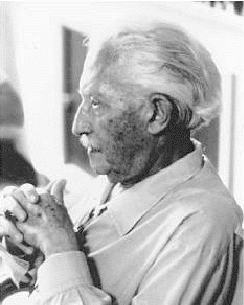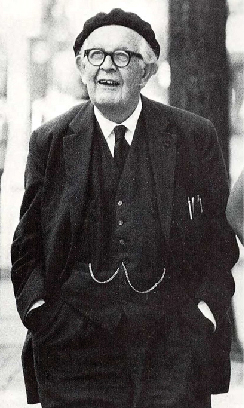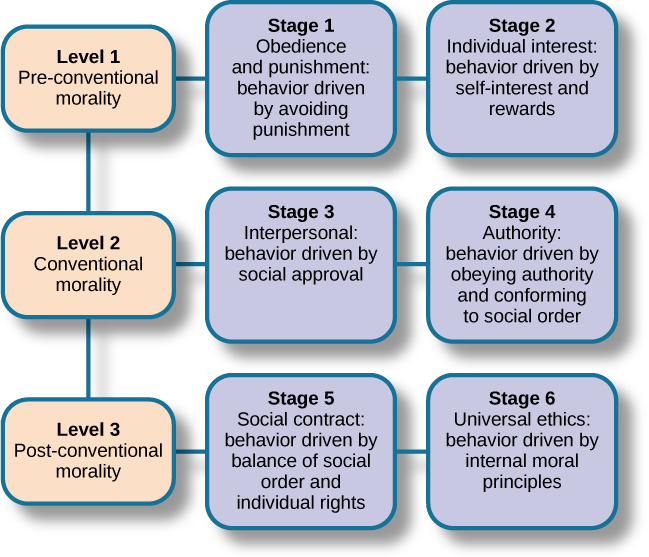Chapter 2: Lifespan Theories
Chapter 2 Learning Objectives
- Discuss Freud’s Theory of psychosexual development.
- Describe the major tasks of child and adult psychosocial development according to Erikson.
- Discuss Piaget’s view of cognitive development and apply the stages to understanding childhood cognition.
- Describe Kohlberg’s theory of moral development.
Freud
Psychosexual Theory of Development
Sigmund Freud (1856–1939) believed that personality develops during early childhood. For Freud, childhood experiences shape our personalities and behavior as adults. Freud viewed development as discontinuous; he believed that each of us must pass through a serious of stages during childhood and that if we lack proper nurturance and parenting during a stage, we may become stuck, or fixated, in that stage. Freud’s stages are called the stages of psychosexual development. According to Freud, children’s pleasure-seeking urges are focused on a different area of the body, called an erogenous zone, at each of the five stages of development: oral, anal, phallic, latency, and genital.
While most of Freud’s ideas have not found support in modern research, we cannot discount the contributions that Freud has made to the field of psychology. Psychologists, today dispute Freud’s psychosexual stages as a legitimate explanation for how one’s personality develops, but what we can take away from Freud’s theory is that personality is shaped, in some part, by experiences we have in childhood. These stages are discussed in detail in the chapter on personality.
Erikson
Psychosocial Theory of Development
Erik Erikson (1902–1994) (Figure 1), another stage theorist, took Freud’s theory and modified it as psychosocial theory. Erikson’s psychosocial development theory emphasizes the social nature of our development rather than its sexual nature. While Freud believed that personality is shaped only in childhood, Erikson proposed that personality development takes place all through the lifespan. Erikson suggested that how we interact with others is what affects our sense of self, or what he called the ego identity.

Erikson proposed that we are motivated by a need to achieve competence in certain areas of our lives. According to psychosocial theory, we experience eight stages of development over our lifespan, from infancy through late adulthood. At each stage, there is a conflict, or task, that we need to resolve. Successful completion of each developmental task results in a sense of competence and a healthy personality. Failure to master these tasks leads to feelings of inadequacy.
According to Erikson (1963), trust is the basis of our development during infancy (birth to 12 months). Therefore, the primary task of this stage is trust versus mistrust. Infants are dependent upon their caregivers, so caregivers who are responsive and sensitive to their infant’s needs help their baby to develop a sense of trust; their baby will see the world as a safe, predictable place. Unresponsive caregivers who do not meet their baby’s needs can engender feelings of anxiety, fear, and mistrust; their baby may see the world as unpredictable.
As toddlers (ages 1–3 years) begin to explore their world, they learn that they can control their actions and act on the environment to get results. They begin to show clear preferences for certain elements of the environment, such as food, toys, and clothing. A toddler’s main task is to resolve the issue of autonomy versus shame and doubt, by working to establish independence. This is the “me do it” stage. For example, we might observe a budding sense of autonomy in a 2-year-old child who wants to choose her clothes and dress herself. Although her outfits might not be appropriate for the situation, her input in such basic decisions has an effect on her sense of independence. If denied the opportunity to act on her environment, she may begin to doubt her abilities, which could lead to low self-esteem and feelings of shame.
Once children reach the preschool stage (ages 3–6 years), they are capable of initiating activities and asserting control over their world through social interactions and play. According to Erikson, preschool children must resolve the task of initiative versus guilt. By learning to plan and achieve goals while interacting with others, preschool children can master this task. Those who do will develop self-confidence and feel a sense of purpose. Those who are unsuccessful at this stage—with their initiative misfiring or stifled—may develop feelings of guilt. How might over-controlling parents stifle a child’s initiative?
During the elementary school stage (ages 6–12), children face the task of industry versus inferiority. Children begin to compare themselves to their peers to see how they measure up. They either develop a sense of pride and accomplishment in their schoolwork, sports, social activities, and family life, or they feel inferior and inadequate when they don’t measure up. What are some things parents and teachers can do to help children develop a sense of competence and a belief in themselves and their abilities?
In adolescence (ages 12–18), children face the task of identity versus role confusion. According to Erikson, an adolescent’s main task is developing a sense of self. Adolescents struggle with questions such as “Who am I?” and “What do I want to do with my life?” Along the way, most adolescents try on many different selves to see which ones fit. Adolescents who are successful at this stage have a strong sense of identity and are able to remain true to their beliefs and values in the face of problems and other people’s perspectives. What happens to apathetic adolescents, who do not make a conscious search for identity, or those who are pressured to conform to their parents’ ideas for the future? These teens will have a weak sense of self and experience role confusion. They are unsure of their identity and confused about the future.
People in early adulthood (i.e., the 20s through early 40s) are concerned with intimacy versus isolation. After we have developed a sense of self in adolescence, we are ready to share our life with others. Erikson said that we must have a strong sense of self before developing intimate relationships with others. Adults who do not develop a positive self-concept in adolescence may experience feelings of loneliness and emotional isolation.
When people reach their 40s, they enter the time known as middle adulthood, which extends to the mid-60s. The social task of middle adulthood is generativity versus stagnation. Generativity involves finding your life’s work and contributing to the development of others, through activities such as volunteering, mentoring, and raising children. Those who do not master this task may experience stagnation, having little connection with others and little interest in productivity and self-improvement.
From the mid-60s to the end of life, we are in a period of development known as late adulthood. Erikson’s task at this stage is called integrity versus despair. He said that people in late adulthood reflect on their lives and feel either a sense of satisfaction or a sense of failure. People who feel proud of their accomplishments feel a sense of integrity, and they can look back on their lives with few regrets. However, people who are not successful at this stage may feel as if their life has been wasted. They focus on what “would have,” “should have,” and “could have” been. They face the end of their lives with feelings of bitterness, depression, and despair. Table 1 summarizes the stages of Erikson’s theory.
| Stage | Age (years) | Developmental Task | Description |
|---|---|---|---|
| 1 | 0–1 | Trust vs. mistrust | Trust (or mistrust) that basic needs, such as nourishment and affection, will be met |
| 2 | 1–3 | Autonomy vs. shame/doubt | Develop a sense of independence in many tasks |
| 3 | 3–6 | Initiative vs. guilt | Take initiative on some activities—may develop guilt when unsuccessful or boundaries overstepped |
| 4 | 7–11 | Industry vs. inferiority | Develop self-confidence in abilities when competent or sense of inferiority when not |
| 5 | 12–18 | Identity vs. confusion | Experiment with and develop identity and roles |
| 6 | 19–29 | Intimacy vs. isolation | Establish intimacy and relationships with others |
| 7 | 30–64 | Generativity vs. stagnation | Contribute to society and be part of a family |
| 8 | 65– | Integrity vs. despair | Assess and make sense of life and meaning of contributions |
Piaget
Cognitive Theory of Development
Jean Piaget (1896–1980) is another stage theorist who studied childhood development (Figure 2). Instead of approaching development from a psychoanalytical or psychosocial perspective, Piaget focused on children’s cognitive growth. He believed that thinking is a central aspect of development and that children are naturally inquisitive. However, he said that children do not think and reason like adults (Piaget, 1930, 1932). His theory of cognitive development holds that our cognitive abilities develop through specific stages, which exemplifies the discontinuity approach to development. As we progress to a new stage, there is a distinct shift in how we think and reason.

Piaget said that children develop schemata to help them understand the world. Schemata are concepts (mental models) that are used to help us categorize and interpret information. By the time children have reached adulthood, they have created schemata for almost everything. When children learn new information, they adjust their schemata through two processes: assimilation and accommodation. First, they assimilate new information or experiences in terms of their current schemata: assimilation is when they take in information that is comparable to what they already know. Accommodation describes when they change their schemata based on new information. This process continues as children interact with their environment.
For example, 2-year-old Blake learned the schema for dogs because his family has a Labrador retriever. When Blake sees other dogs in his picture books, he says, “Look mommy, dog!” Thus, he has assimilated them into his schema for dogs. One day, Blake sees a sheep for the first time and says, “Look mommy, dog!” Having a basic schema that a dog is an animal with four legs and fur, Blake thinks all furry, four-legged creatures are dogs. When Blake’s mom tells him that the animal he sees is a sheep, not a dog, Blake must accommodate his schema for dogs to include more information based on his new experiences. Blake’s schema for a dog was too broad since not all furry, four-legged creatures are dogs. He now modifies his schema for dogs and forms a new one for sheep.
Like Freud and Erikson, Piaget thought development unfolds in a series of stages approximately associated with age ranges. He proposed a theory of cognitive development that unfolds in four stages: sensorimotor, preoperational, concrete operational, and formal operational (Table 2).
| Age (years) | Stage | Description | Developmental issues |
|---|---|---|---|
| 0–2 | Sensorimotor | The world experienced through senses and actions | Object permanence Stranger anxiety |
| 2–6 | Preoperational | Use words and images to represent things, but lack logical reasoning | Pretend play Egocentrism Language development |
| 7–11 | Concrete operational | Understand concrete events and analogies logically; perform arithmetical operations | Conservation Mathematical transformations |
| 12– | Formal operational | Formal operations Utilize abstract reasoning |
Abstract logic Moral reasoning |
The first stage is the sensorimotor stage, which lasts from birth to about 2 years old. During this stage, children learn about the world through their senses and motor behavior. Young children put objects in their mouths to see if the items are edible, and once they can grasp objects, they may shake or bang them to see if they make sounds. Between 5 and 8 months old, the child develops object permanence, which is the understanding that even if something is out of sight, it still exists (Bogartz, Shinskey, & Schilling, 2000). According to Piaget, young infants do not remember an object after it has been removed from sight. Piaget studied infants’ reactions when a toy was first shown to an infant and then hidden under a blanket. Infants who had already developed object permanence would reach for the hidden toy, indicating that they knew it still existed, whereas infants who had not developed object permanence would appear confused.

Please take a few minutes to view this brief video above demonstrating different children’s ability to understand object permanence.
In Piaget’s view, around the same time children develop object permanence, they also begin to exhibit stranger anxiety, which is a fear of unfamiliar people. Babies may demonstrate this by crying and turning away from a stranger, by clinging to a caregiver, or by attempting to reach their arms toward familiar faces such as parents. Stranger anxiety results when a child is unable to assimilate the stranger into an existing schema; therefore, she can’t predict what her experience with that stranger will be like, which results in a fear response.
Piaget’s second stage is the preoperational stage, which is from approximately 2 to 7 years old. In this stage, children can use symbols to represent words, images, and ideas, which is why children in this stage engage in pretend play. A child’s arms might become airplane wings as he zooms around the room, or a child with a stick might become a brave knight with a sword. Children also begin to use language in the preoperational stage, but they cannot understand adult logic or mentally manipulate information (the term operational refers to logical manipulation of information, so children at this stage are considered to be pre-operational). Children’s logic is based on their own personal knowledge of the world so far, rather than on conventional knowledge. For example, dad gave a slice of pizza to 10-year-old Keiko and another slice to her 3-year-old brother, Kenny. Kenny’s pizza slice was cut into five pieces, so Kenny told his sister that he got more pizza than she did. Children in this stage cannot perform mental operations because they have not developed an understanding of conservation, which is the idea that even if you change the appearance of something, it is still equal in size as long as nothing has been removed or added.
During this stage, we also expect children to display egocentrism, which means that the child is not able to take the perspective of others. A child at this stage thinks that everyone sees, thinks, and feels just as they do. Let’s look at Kenny and Keiko again. Keiko’s birthday is coming up, so their mom takes Kenny to the toy store to choose a present for his sister. He selects an Iron Man action figure for her, thinking that if he likes the toy, his sister will too. An egocentric child is not able to infer the perspective of other people and instead attributes his own perspective.
Piaget’s third stage is the concrete operational stage, which occurs from about 7 to 11 years old. In this stage, children can think logically about real (concrete) events; they have a firm grasp on the use of numbers and start to employ memory strategies. They can perform mathematical operations and understand transformations, such as addition is the opposite of subtraction, and multiplication is the opposite of division. In this stage, children also master the concept of conservation: Even if something changes shape, its mass, volume, and number stay the same. For example, if you pour water from a tall, thin glass to a short, fat glass, you still have the same amount of water. Remember Keiko and Kenny and the pizza? How did Keiko know that Kenny was wrong when he said that he had more pizza?
Children in the concrete operational stage also understand the principle of reversibility, which means that objects can be changed and then returned back to their original form or condition. Take, for example, water that you poured into the short, fat glass: You can pour water from the fat glass back to the thin glass and still have the same amount (minus a couple of drops).
The fourth, and last, stage in Piaget’s theory is the formal operational stage, which is from about age 11 to adulthood. Whereas children in the concrete operational stage are able to think logically only about concrete events, children in the formal operational stage can also deal with abstract ideas and hypothetical situations. Children in this stage can use abstract thinking to problem solve, look at alternative solutions, and test these solutions. In adolescence, a renewed egocentrism occurs. For example, a 15-year-old with a very small pimple on her face might think it is huge and incredibly visible, under the mistaken impression that others must share her perceptions.
Beyond Formal Operational Thought
As with other major contributors to theories of development, several of Piaget’s ideas have come under criticism based on the results of further research. For example, several contemporary studies support a model of development that is more continuous than Piaget’s discrete stages (Courage & Howe, 2002; Siegler, 2005, 2006). Many others suggest that children reach cognitive milestones earlier than Piaget describes (Baillargeon, 2004; de Hevia & Spelke, 2010).
According to Piaget, the highest level of cognitive development is formal operational thought, which develops between 11 and 20 years old. However, many developmental psychologists disagree with Piaget, suggesting a fifth stage of cognitive development, known as the post formal stage (Basseches, 1984; Commons & Bresette, 2006; Sinnott, 1998). In post formal thinking, decisions are made based on situations and circumstances, and logic is integrated with emotion as adults develop principles that depend on contexts. One way that we can see the difference between an adult in post formal thought and an adolescent in formal operations is in terms of how they handle emotionally charged issues.
It seems that once we reach adulthood our problem-solving abilities change: As we attempt to solve problems, we tend to think more deeply about many areas of our lives, such as relationships, work, and politics (Labouvie-Vief & Diehl, 1999). Because of this, post formal thinkers are able to draw on past experiences to help them solve new problems. Problem-solving strategies using post formal thought vary, depending on the situation. What does this mean? Adults can recognize, for example, that what seems to be an ideal solution to a problem at work involving a disagreement with a colleague may not be the best solution to a disagreement with a significant other.
Kohlberg
Theory of Moral Development
A major task beginning in childhood and continuing into adolescence is discerning right from wrong. Psychologist Lawrence Kohlberg (1927–1987) extended upon the foundation that Piaget built regarding cognitive development. Kohlberg believed that moral development, like cognitive development, follows a series of stages. To develop this theory, Kohlberg posed moral dilemmas to people of all ages, and then he analyzed their answers to find evidence of their particular stage of moral development. Before reading about the stages, take a minute to consider how you would answer one of Kohlberg’s best-known moral dilemmas, commonly known as the Heinz dilemma:
In Europe, a woman was near death from a special kind of cancer. There was one drug that the doctors thought might save her. It was a form of radium that a druggist in the same town had recently discovered. The drug was expensive to make, but the druggist was charging ten times what the drug cost him to make. He paid $200 for the radium and charged $2,000 for a small dose of the drug. The sick woman’s husband, Heinz, went to everyone he knew to borrow the money, but he could only get together about $1,000, which is half of what it cost. He told the druggist that his wife was dying and asked him to sell it cheaper or let him pay later. But the druggist said: “No, I discovered the drug and I’m going to make money from it.” So Heinz got desperate and broke into the man’s store to steal the drug for his wife. Should the husband have done that? (Kohlberg, 1969, p. 379)
How would you answer this dilemma? Kohlberg was not interested in whether you answer yes or no to the dilemma: Instead, he was interested in the reasoning behind your answer.
After presenting people with this and various other moral dilemmas, Kohlberg reviewed people’s responses and placed them in different stages of moral reasoning (Figure 3). According to Kohlberg, an individual progresses from the capacity for pre-conventional mortality (before age 9) to the capacity for conventional morality (early adolescence), and toward attaining post-conventional morality (once formal operational thought is attained), which only a few fully achieve. Kohlberg placed in the highest stage responses that reflected the reasoning that Heinz should steal the drug because his wife’s life is more important than the pharmacist making money. The value of human life overrides the pharmacist’s greed.

It is important to realize that even those people who have the most sophisticated, post-conventional reasons for some choices may make other choices for the simplest of pre-conventional reasons. Many psychologists agree with Kohlberg’s theory of moral development but point out that moral reasoning is very different from moral behavior. Sometimes what we say we would do in a situation is not what we actually do in that situation. In other words, we might “talk the talk,” but not “walk the walk.”
How does this theory apply to males and females? Kohlberg (1969) felt that more males than females move past stage four in their moral development. He went on to note that women seem to be deficient in their moral reasoning abilities. These ideas were not well received by Carol Gilligan, a research assistant of Kohlberg, who consequently developed her own ideas of moral development. In her groundbreaking book, In a Different Voice: Psychological Theory and Women’s Development, Gilligan (1982) criticized her former mentor’s theory because it was based only on upper-class White men and boys. She argued that women are not deficient in their moral reasoning—she proposed that males and females reason differently. Girls and women focus more on staying connected and the importance of interpersonal relationships. Therefore, in the Heinz dilemma, many girls and women respond that Heinz should not steal the medicine. Their reasoning is that if he steals the medicine, is arrested, and is put in jail, then he and his wife will be separated, and she could die while he is still in prison.
Additional Resources
This brief video demonstrates different children’s ability to understand object permanence according to Jean Piaget’s Stages of Cognitive Development in stage one: sensorimotor stage.
This video shows a 4.5-year-old boy in the preoperational stage as he responds to Piaget’s conservation tasks in the Stages of Cognitive Development.
Piaget developed the Three-Mountain Task to determine the level of egocentrism displayed by children. Children view a 3-dimensional mountain scene from one viewpoint and are asked what another person at a different viewpoint would see in the same scene. Watch the Three-Mountain Task in action in this short video from the University of Minnesota and the Science Museum of Minnesota which represents Piaget’s preoperational stage.
End-of-Chapter Summary
There are many theories regarding how babies and children grow and develop into happy, healthy adults. Sigmund Freud suggested that we pass through a series of psychosexual stages in which our energy is focused on certain erogenous zones on the body. Eric Erikson modified Freud’s ideas and suggested a theory of psychosocial development. Erikson said that our social interactions and successful completion of social tasks shape our sense of self. Jean Piaget proposed a theory of cognitive development that explains how children think and reason as they move through various stages. Finally, Lawrence Kohlberg turned his attention to moral development. He said that we pass through three levels of moral thinking that build on our cognitive development.
Attribution
Adapted from Chapter 9.2: Lifespan Theories in OpenStax, Psychology. OpenStax CNX. Oct 2, 2019 http://cnx.org/contents/4abf04bf-93a0-45c3-9cbc-2cefd46e68cc@12.2. Download for free athttp://cnx.org/contents/4abf04bf-93a0-45c3-9cbc-2cefd46e68cc@12.2.

